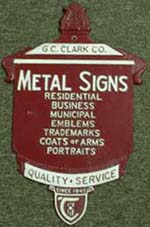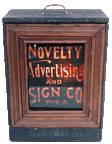|
|

Salesman's Samples & Ad
Specialties
The exquisite 4-3/4 x 7-in. glass panels are from
the portfolio of George Brooke, a late 19th century Portland,
OR signpainter. The glass pieces were collected in a notebook, which
was signed by Brooke and dates November 10, 1870 - Kansas
City, MO. The collection was purchased from the estate of the late
Rick Glawson, former member of the Museum's Board of Trustees.

The salesman sample sign was acquired in its
original felt-lined carrying case, which included an extra lighting
fixture. The etched glass sign is bottom edge-lit. Crystal
Signs was a top-of-the-line manufacturer of point-of-purchase
signs in the 1920s through the 1940s.
|

|
The single-faced, embossed baked
enamel Consolite Corp. sign measures 20 x 28
in.
|
|
The cast metal plaque for
G.C. Clarke Co. measures 10-1/2 x 16
in.
|

|
|
A sample for customers,
John Trantina fashioned this 7 x 30 x 34-in. sign's
colonial-style, double-faced can of pressboard. The
painted tin faces are tilted back so the
incandescent bulb recessed in the top section
washes indirect light down upon the sign
faces.
|

|

|
|
Will Miller, Miller Signs, Glen
Rock, NJ, passed along to the Museum a sample of
"Mac" McDonald's goldleaf samples which had
hung on the wall of his mentor's shop. "Mac," who
passed away in April of 1996, had primarily been a
theatre artist and was featured as such in a
September/October issue of Signcraft Magazine.
Miller owns a collection of Mac's theatre posters
that he dearly treasures. Miller, himself,
specializes in gilded carved signs.
|
|
The combination neon
clock/flip-ad display was manufactured by
Electric Ad Clock Co., Chicago, IL. These vintage
p-o-p displays flooded the antique advertising
market several years ago when the company's former
warehouse was discovered. This particular
acquistion, however, was a salesman's sample and
included a hardshell case, blank flip-ads, order
forms, etc. and the individual "ads" touted the
promotional value of the display.
|
|
|

|
Although this hospital
directory is presently in less than good
condition, the piece is very interesting from the
standpoint that it was a sample H.R. Strachan Inc.,
Brooklyn, NY, used to sell signs in the late 1920s.
There is a letter and photograph that accompanied
the sample from Lewis E. Birdseye, Superintendent
of the Jewish Hospital, attesting to an actual
installation of the sample sign. The sample display
is a corner section for a sign directory that would
announce whether a doctor was "in" by lighting up
that respective doctor's name. If the doctor is not
"in," his name remains dark. The sign consists of a
copper cabinet with translucent white inserts for
the doctor's individual names.
|
|
The salesman's sample for the
Novelty Sign and Adv. Co., Philadelphia, PA,
serves a dual purpose: One side depicts an
incandescent backlit, handpainted glass sign; the
reverse side shows an example of a scroll sign in
which numerous messages were painted in sequence on
a roll, which could be manually turned. The sign
was intended for indoor and probably dates to the
1920s.
|
 
|
|
Home
| News | Exhibits
|
Links
| FAQ | Contact
Us
|
|